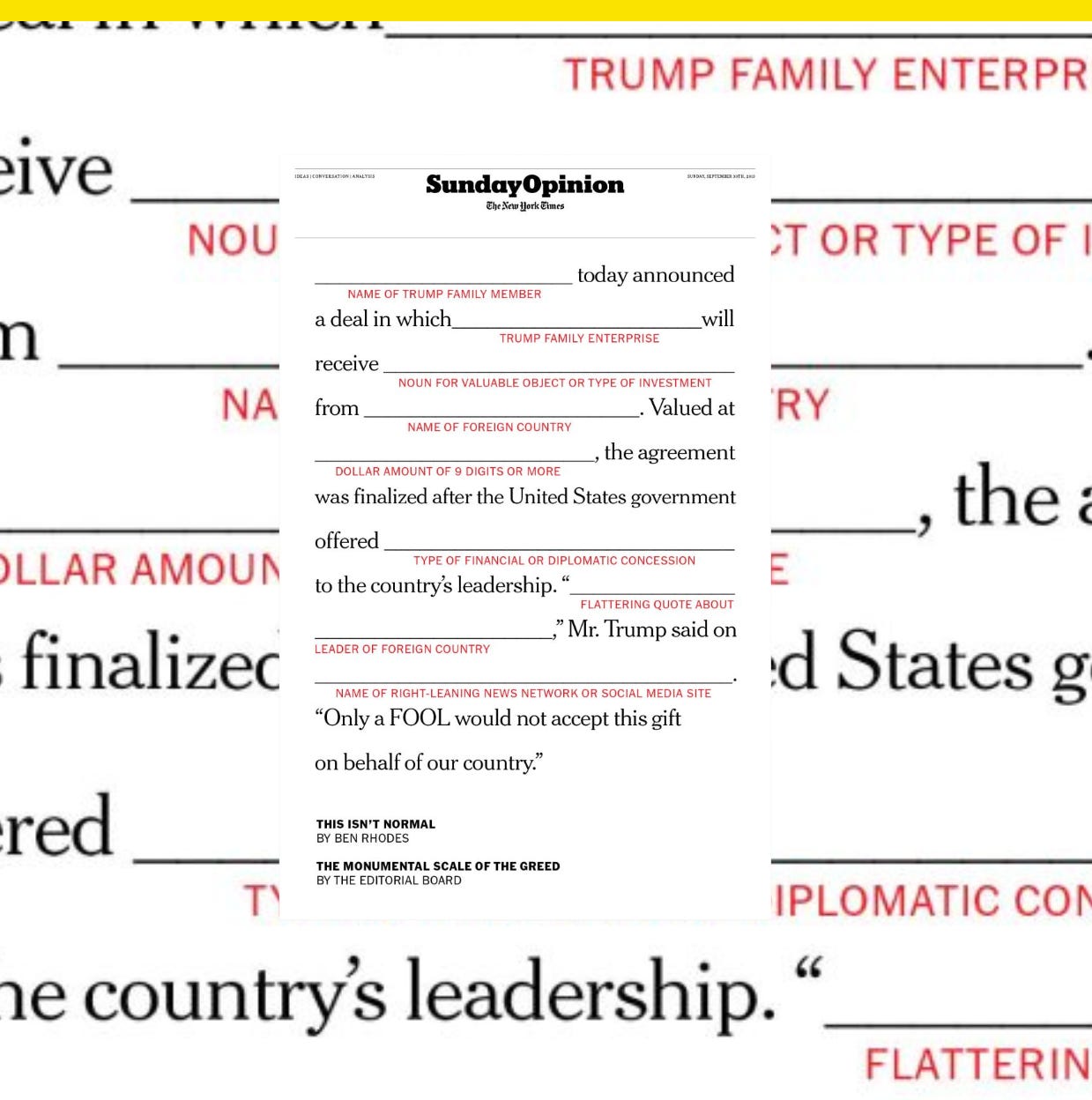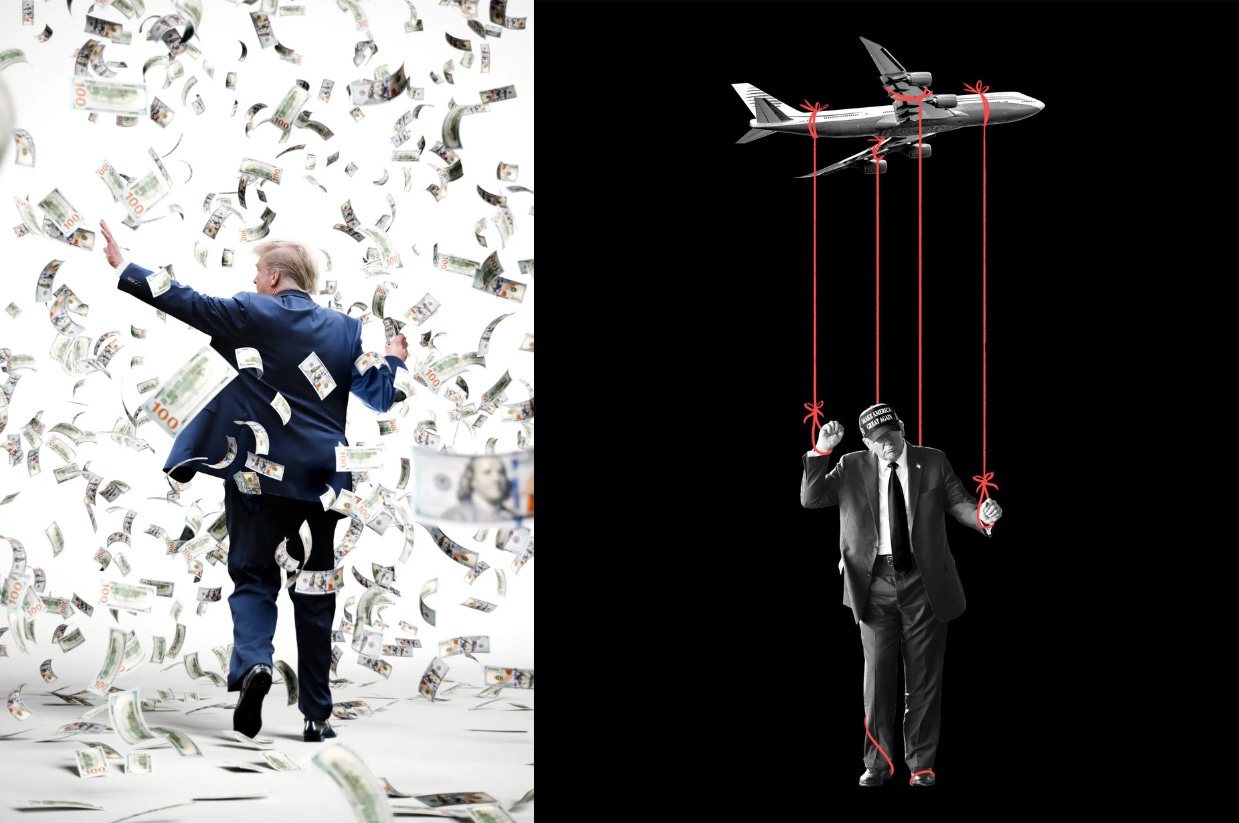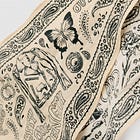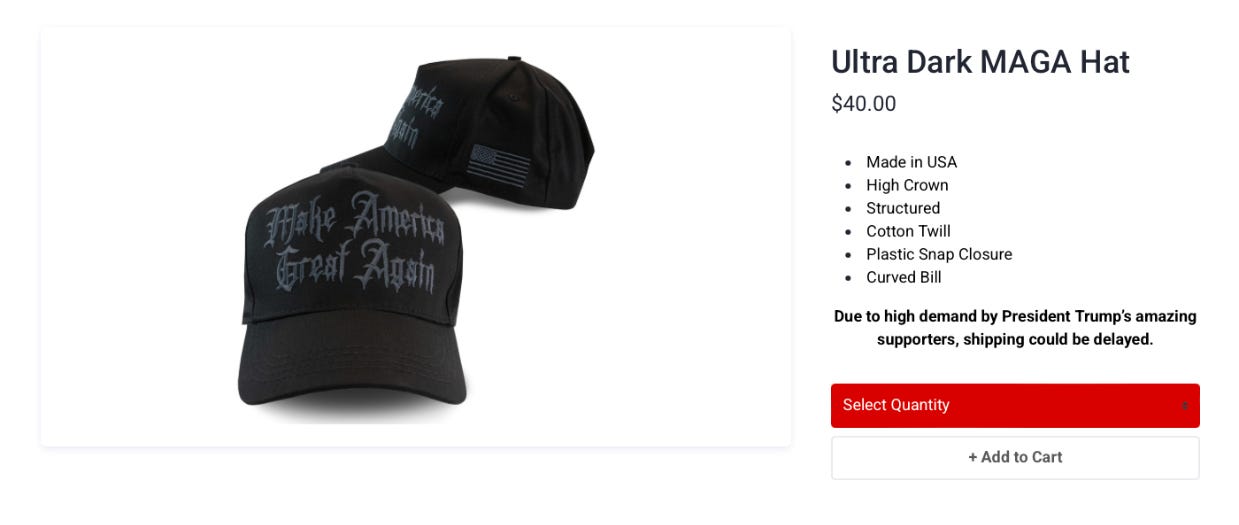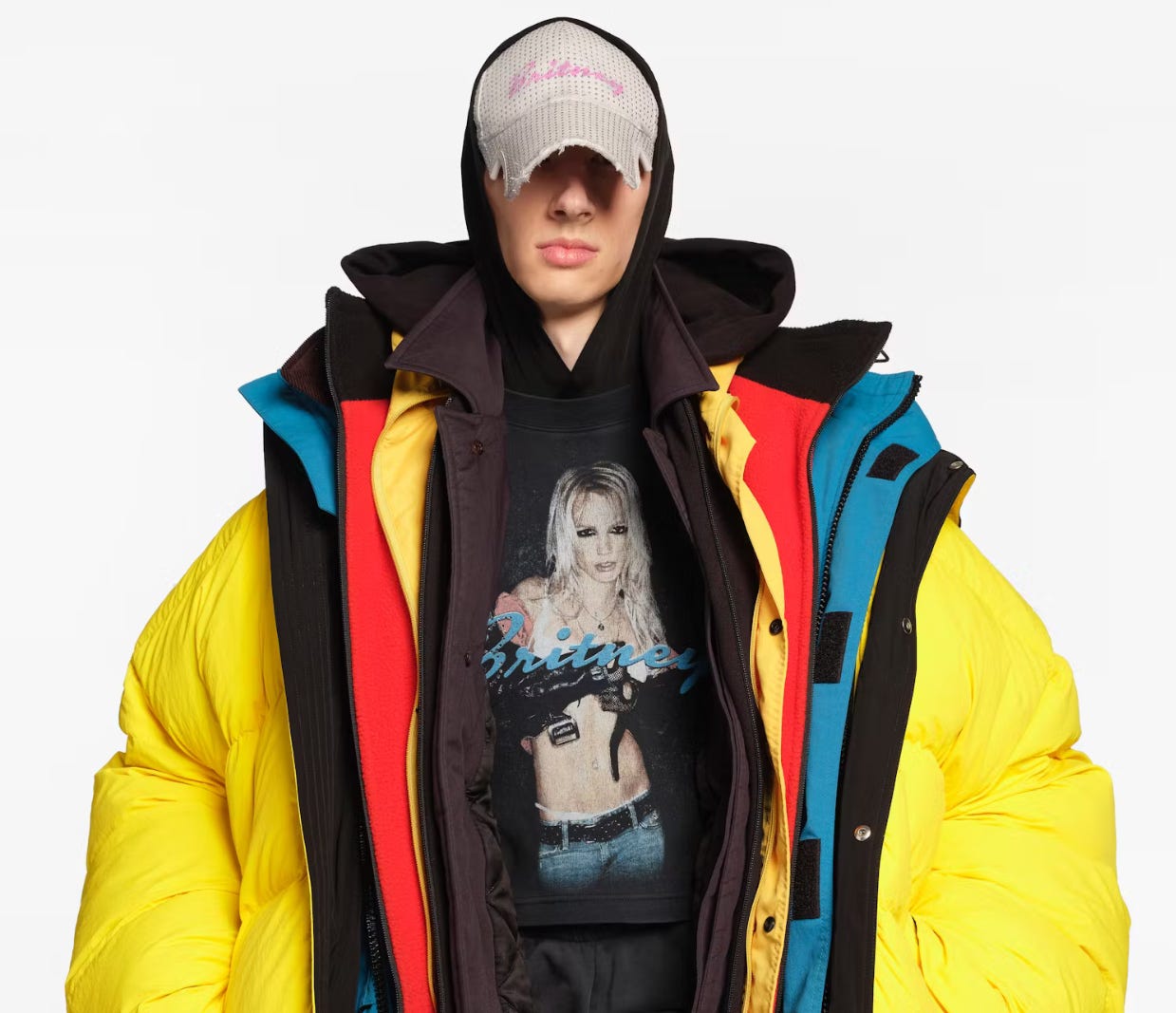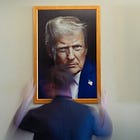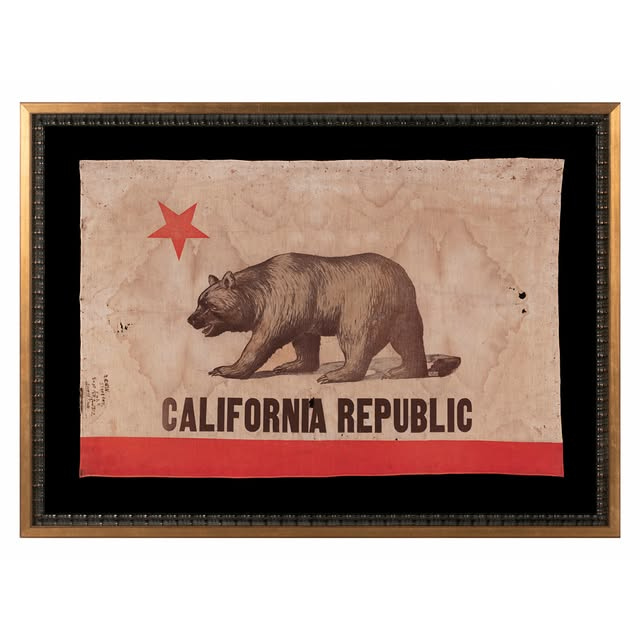How to visualize Trump’s corruption without filling in all the blanks
Plus: The lasting design legacy of Elon Musk’s MAGA era
How to visualize Trump’s corruption without filling in all the blanks
To illustrate how President Donald Trump’s corruption is warping our political system and how to push back, the New York Times left open spaces for readers to fill in themselves. A graphic of a fill-in-the-blank form was used to illustrate two essays Sunday, and the clever illustration manages to draw attention to Trump’s self-dealing without focusing on a single, specific example.
“[Name of Trump Family Member] today announced a deal in which [Trump Family Enterprise] will receive [Noun for Valuable Object or Type of Investment] from [Name of Foreign Country],” the illustration reads. “Valued at [Dollar Amount of 9 Digits or More], the agreement was finalized after the United States government offered [Type of Financial or Diplomatic Concession] to the country’s leadership.”
The effect is to paint Trump family scandals like Mad Libs, and it gets at a larger point. A growing culture of corruption under Trump’s second term has no modern precedent in U.S. presidential history, from his company’s six real estate projects in Middle East nations to “Executive Branch,” the private Georgetown club first son Donald Trump Jr. is opening with a $500,000 entrance fee. We’ve never seen anything like it.
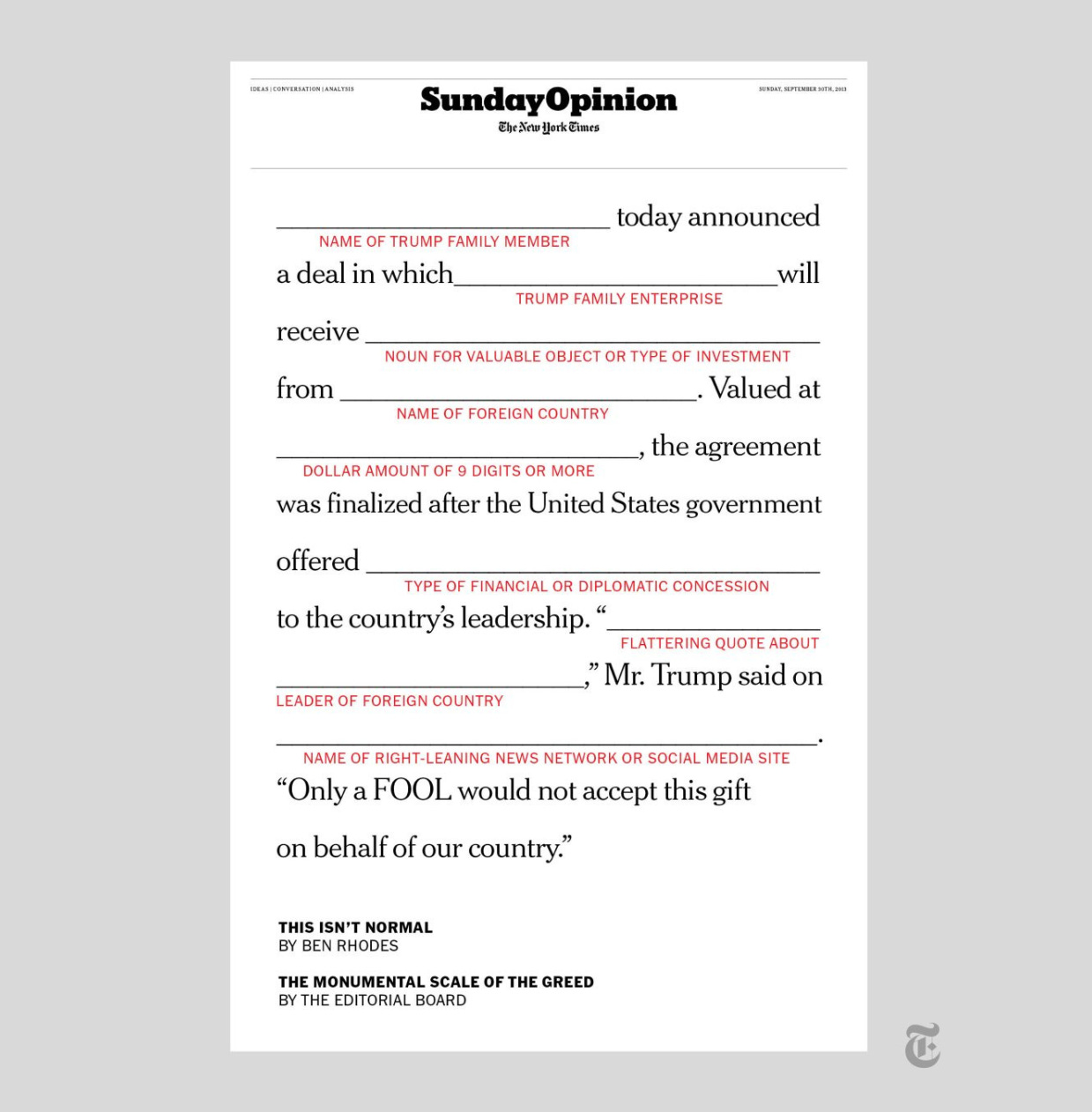
What’s more, when done shamelessly and out in the open, Trump’s second-term pay-for-play posture normalizes corruption. The Times Sunday Opinion called for pausing and taking stock of what’s happened since Trump took power four months ago with two pieces. One, by the Editorial Board, argues “the self-enrichment of the second Trump administration is different from old-fashioned corruption,” and the second, by Ben Rhodes, a former U.S. deputy national security adviser under former President Barack Obama, draws attention to an astonishing fact — Trump’s personal wealth has more than doubled from the time he started his 2024 — and he compares Trump to authoritarian strongmen in other countries.
“During Mr. Trump’s first term, he frequently used his powers to reward himself. He held government events at his hotels, and his family business continued to make deals involving foreign governments, in an apparent violation of the constitutional prohibition of enrichment from foreign leaders,” the Times Editorial Board wrote. “But those erasures of ethical norms now look like a dress rehearsal for the ultimate production of the second term.”
Trump’s using the power of his office to negotiate tariffs with countries like Vietnam, where the government fast tracked a Trump golf course, and he’s settled for millions of dollars with media companies he’s sued for practicing their First Amendment-guaranteed Freedom of Speech. And then, of course, there’s the jet from Qatar and Trump’s lucrative embrace of cryptocurrency just as his administration takes a less regulatory stance on the industry.
“People who make Mr. Trump richer regularly receive favorable treatment from the government he runs,” the Editorial Board wrote.
The Times Opinion section has a knack for using simple typography as a form of editorial illustration, like a page last October that laid out what Trump said he would do if he took power for a second term that’s unfortunately proven all too prescient (“Donald Trump says he will prosecute his enemies, order mass deportations, use soldiers against citizens, abandon allies, play politics with disasters,” it said. “Believe him.”).
Making clever use of type and space for this weekend’s illustration, designers for the Times Sunday Opinion under designer director Frank Augugliaro illustrated what corruption looks like under Trump now. This is corruption so routine it takes a form letter just to keep track, so flagrant the page reads like parody press release proudly announcing the Trump Organization’s latest shady deal.
The two pieces were illustrated with other art, including a photo illustration by Pablo Delcan showing Trump surrounded by $100 bills as if in an arcade money booth, and Trump with strings attached to the gift jet by Rebecca Chew. The message is clear: Trump is cashing in and compromised.
Rhodes, the author of “After the Fall” about the rise of nationalism and authoritarianism around the world, argues for a new birth of progressive American populism, like seen in response to the Gilded Age.
“We’ve had bad presidents before, but none who have personally profited as much from the office,” he wrote. “Markets and institutions can impose some guardrails, but ultimately nothing will impose a meaningful check like the mobilization of the American people.”
Previously in Yello:
Don’t take this newsletter for granted. Yello is a reader-supported publication that relies on support from readers like you. Chip in today and subscribe:
The lasting design legacy of Elon Musk’s MAGA era
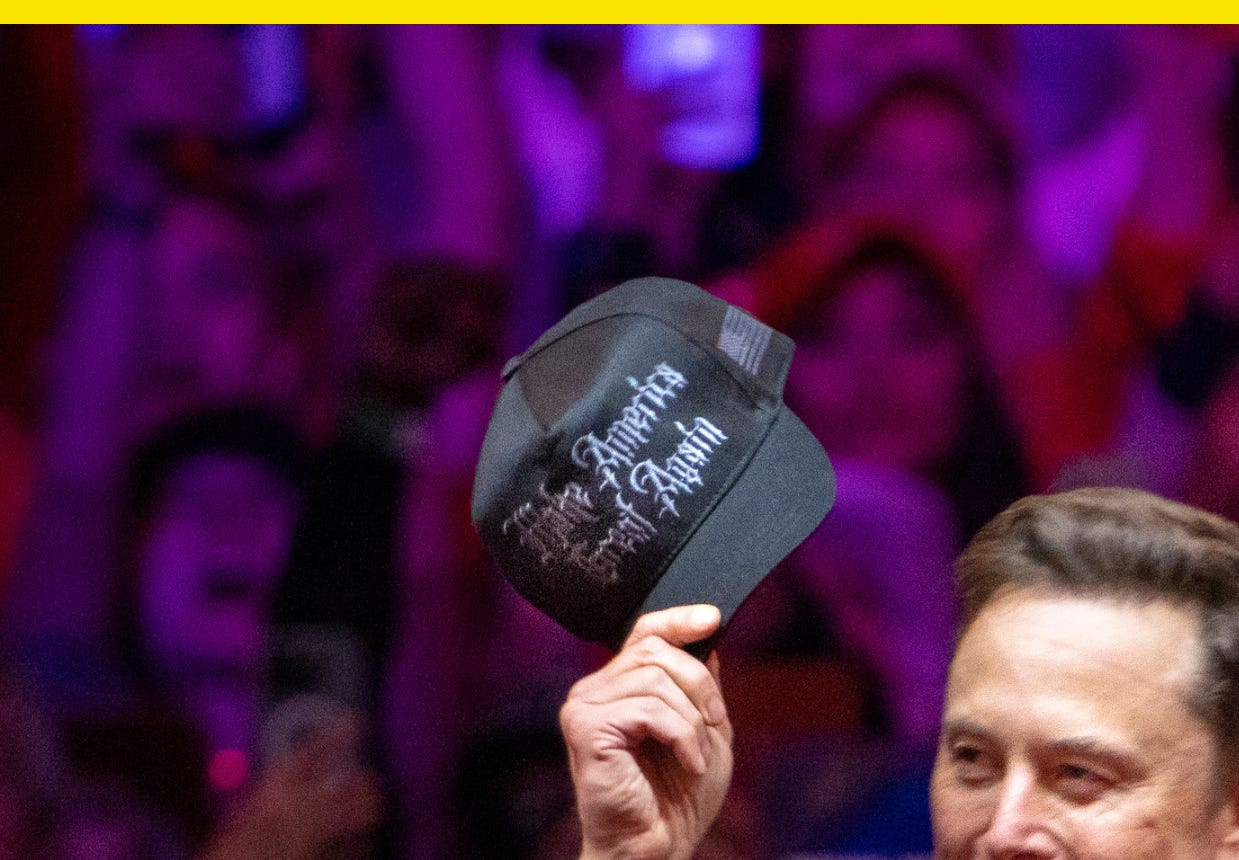
Trump’s friendship with Elon Musk might be over, but Musk’s unlikely influence on the look of Trumpism lives on.
The pair’s breakup was swift, Musk’s already apologizing (and deleted his tweet about Jeffrey Epstein), and Trump’s all but declared war on California and forced the news cycle on. But no matter Musk’s future interactions with Trump, one thing is clear: Musk’s tweets aren’t funny, his trucks suck, and he brightens up every room he leaves, but still, he helped revitalize Trump’s political brand by bringing Big Tech cred to MAGA in 2024. And though his hats are too big for his head and his t-shirts are too small for his belly, more than any other person he popularized a new aesthetic for the movement.
“I’m not just MAGA, I’m dark gothic MAGA,” Musk said at a Trump rally in New York City wearing a black-on-black gothic font “Make America Great Again” hat last October. A successful sub-brand of MAGA hats was born, and significantly, it allowed people to support Trump without wearing the red hat with all its associated baggage. “I don’t want to wear a bright-red MAGA hat, that’s cringe,” Jessie Whitney, a New York voter who voted for Democrats before 2024 told the Wall Street Journal about the look of “Dark MAGA.”
It was a new look for an unusually old political brand. Republicans used a Cybertruck in a video during their 2024 convention, and Musk, along with former Democrats Robert F. Kennedy Jr. and Tulsi Gabbard were among the figures in one of the Trump campaign’s closing ads of the 2024 race produced to show the MAGA movement as evolved, bipartisan, and new.
Musk is now out, but the fact the Trump store looks like his closet is a testament to his unusually close ties to the president. Today you can buy a $40 Ultra Dark MAGA hat with gothic type in the Trump campaign shop or a Dark MAGA version in serifs. There’s also $35 black-on-black tees, a $40 DOGE hat with golden dollar signs on the sides for the so-called Department of Government Efficiency Musk pushed for and worked on, and “Gulf of America” hats like Musk wore in public, though in different colorways.
Musk’s “Dark Gothic MAGA” preceded Trump’s “Golden Age,” and you couldn’t have one without the other. Musk, who donated more than $291 million during the 2024 campaign, certainly thinks so. “Without me, Trump would have lost the election,” he tweeted last week. And without him, Trump also wouldn’t be selling a hat that said “DOGE.”
Have you seen this?
How these hot pink chairs became a symbol of the L.A. protests. The architecture firm Rios designed the street furniture for Gloria Molina Grand Park to have “endless configurations.” They never could have imagined it would be used as a shield. [Fast Company]
Britney Spears collaborated with Balenciaga. The brand dropped its spring 2026 collection, “Exactitudes,” and a collaboration with the princess of pop that includes limited-edition merch and a curated playlist. [W Magazine]
Trump trips. This week in Washington, friends became enemies and former Democratic press secretaries became independent. At least there’s going to be a fashion coffee table book for a certain well-dressed former FLOTUS coming. [Whig]
History of political design
California Bear Flag (1912). The California legislature approved a state flag in 1911 that called for a red star and stripe, bear, and the words "California Republic," but there was no standard design.
Like what you see? Subscribe for more:


